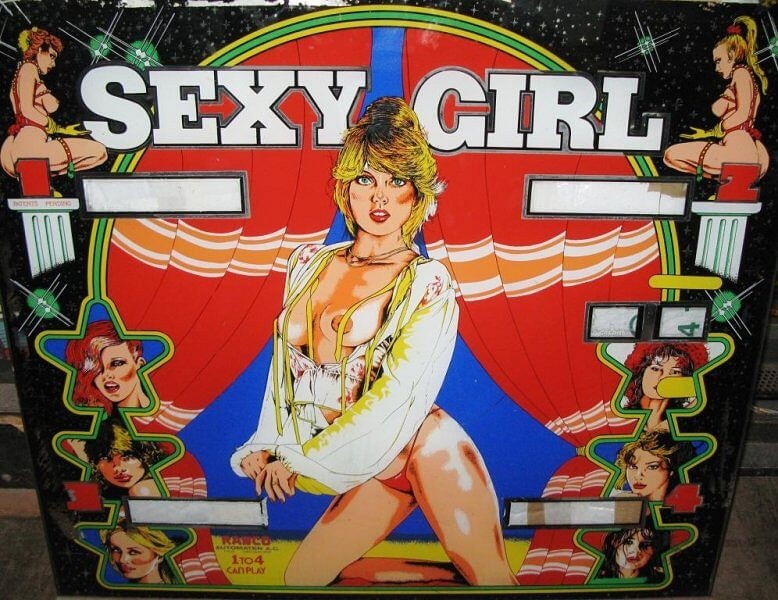


Although the playfield layout for this conversion kit is identical to Bally's 1978 'Playboy', Sexy Girl was advertised for use on all Bally electronic pins of the time. The kit consisted of a wired playfield, backglass, projector, film cartridge, and instruction manual. Cabinet decals were not mentioned as part of this kit, yet we note that the few cabinets shown here all have the same generic art which did not appear on Bally games. A collector from Germany told us that Arkon did the conversion and repainted the cabinets. Perhaps, then, this manufacturer made Sexy Girl as a converted game, in addition to marketing this as a conversion kit where it is intended for operators to do all the work of converting. There was a Sexy Girl conversion kit made specifically for Bally's 1980 'Silverball Mania' which accounted for the backglass carry-over feature in that game. We show it in a separate listing as Arkon Automaten's 1983 'Sexy Girl (Delux)'. The manufacturer's flyer and some of the games shown here are branded with more than one company name, depending where on the game one looks. We list the company names and where we found them: Backglass: Ranco Automaten A.G. of Thun, Switzerland Apron: Ranco Automaten A.G. of Thun, Switzerland Bell Coin Matics of Italy (a maker of conversion kits) Film Cartridge: Ranco Automaten A.G. (blue label only) Arkon Automaten GMBH (both blue and brown labels) Flyer: Arkon Automaten GMBH of Frankfurt, Germany Pinball Vision, a division of Arc, Inc. of Weymouth, Massachusetts, USA Because we know that backglasses and aprons are portable thus can be exchanged between machines, we had been uncertain as to who was the actual manufacturer or if there was more than one. In our Files section is a letter we received in 2005 from Reinhard Deutsch, the inventor of the Picture Pin�, who explained that he owned both Ranco and Arkon companies. He referenced his relationship to Bell Coin Matics and to Pinball Vision. Uwe Burkheiser, the USA distributor for this game, clarified for us the roles the different companies played:Ranco (Switzerland) was Reinhard�s distribution arm for European sales outside of Germany. Pinball Vision (Weymouth US) was the distributor for the Americas and ran by me (living in Boston at the time) as a favour to Reinhard who was bound to Frankfurt/Main � Germany the home of Arkon Automaten GmbH. Reinhard concentrated (with Arkon/Germany) on the modification of the Bally electronics of the conversions (difficult enough at that time) while the backglasses and the aprons where made by either Bell Coin Matics/Italy or a small local supplier to Ranco/Switzerland, which explains their names on these parts. I grant you that the various names may have created confusion in the marketplace. However, the legal setup at that time in Europe required for all these parts the manufacturer to be named on the part � when crossing country borders. From a factual and economic perspective Reinhard Deutsch via Arkon Automaten GmbH, Frankfurt/Main, Germany, was the centre of the wheel and the inventor. All else are administrative or distributive additives/necessities. The manufacturer flyer indicates 200 pin-up images are in this kit. Two cassettes are shown here, one with a blue label and one with a brown label. We do not know if the content differs between them, but a collector counted only 190 images on the film loop in his blue-labeled cassette. In the Files section are eproms that will not work with any standard MPU Board jumper setting. Users must refer to the accompanying file of pictures that show the unusual jumper setting. Depicted on the backglass is model Ann Pennington from her centerfold pose in Playboy, March 1976.
Loading leaderboard...